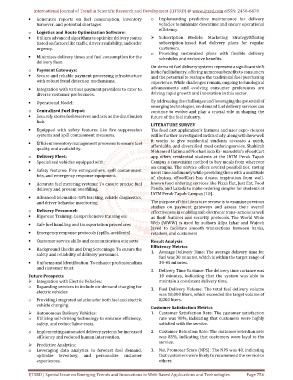Page 766 - Emerging Trends and Innovations in Web-Based Applications and Technologies
P. 766
International Journal of Trend in Scientific Research and Development (IJTSRD) @ www.ijtsrd.com eISSN: 2456-6470
· Generates reports on fuel consumption, inventory o Implementing predictive maintenance for delivery
turnover, and potential shortages. vehicles to minimize downtime and ensure operational
efficiency.
o Logistics and Route Optimization Software:
· Utilizes advanced algorithms to optimize delivery routes Subscription Models: Marketing StrategyOffering
based on factors like traffic, driver availability, and order subscription-based fuel delivery plans for regular
urgency. customers.
o Providing customized plans with flexible delivery
· Minimizes delivery times and fuel consumption for the
schedules and exclusive benefits.
delivery fleet.
On-demand fuel delivery systems represent a significant shift
o Payment Gateways: in the fuel industry, offering numerous benefits to consumers
· Secure and reliable payment processing infrastructure and the potential to reshape the traditional fuel purchasing
with robust fraud detection mechanisms. experience. While challenges remain, ongoing technological
· Integration with various payment providers to cater to advancements and evolving consumer preferences are
diverse customer preferences. driving rapid growth and innovation in this sector.
· Operational Model: By addressing the challenges and leveraging the potential of
emerging technologies, on-demand fuel delivery services can
o Centralized Fuel Depot: continue to evolve and play a crucial role in shaping the
· Securely stores fuel reserves and acts as the distribution future of the fuel industry.
hub.
LITERATURE SURVEY
· Equipped with safety features like fire suppression The food cart application’s features and user expe- riences
systems and spill containment measures. will be further investigated in this study, along with how well
· Efficient inventory management processes to ensure fuel it works to give residential students accessto a quick,
quality and availability. affordable, and diversified meal orderingservice. Shahirah
Mohamed Hatim and Norhaslinda Ka- maruddin’s eFoodCart
o Delivery Fleet: app offers residential students at the UiTM Perak Tapah
· Specialized vehicles equipped with: Campus a convenient method to buy meals from wherever
on campus. The service offers several possibilities, saving
· Safety features: Fire extinguishers, spill containment
users time and money while providing them with a multitude
kits, and emergency response equipment.
of choices. eFoodCart has drawn inspiration from well-
· Accurate fuel metering systems: To ensure precise fuel known food ordering services like Pizza Hut, Just Eat, Food
delivery and prevent overfilling. Panda, and Lazada to make ordering simpler for students at
UiTM Perak Tapah Campus [10].
· Advanced telematics: GPS tracking, vehicle diagnostics,
and driver behavior monitoring. The purpose of this literature review is to examine previous
studies on payment gateways and assess their overall
o Delivery Personnel: effectiveness in enabling safe electronic trans- actions as well
· Rigorous Training: Comprehensive training on: as their features and security protocols. The World Wide
· Safe fuel handling and transportation procedures Web (WWW) is used by authors Ailya Izhar and Wajeeh
Javed to facilitate smooth transactions between banks,
· Emergency response protocols (spills, accidents) retailers, and customers
· Customer service skills and communication etiquette Result Analysis
· Background Checks and Drug Screenings: To ensure the Efficiency Metrics
1. Average Delivery Time: The average delivery time for
safety and reliability of delivery personnel.
fuel was 30 minutes, which is within the target range of
· Uniforms and Identification: To enhance professionalism 30-45 minutes.
and customer trust.
2. Delivery Time Variance: The delivery time variance was
Future Prospects 10 minutes, indicating that the system was able to
Integration with Electric Vehicles: maintain a consistent delivery time.
o Expanding services to include on-demand charging for
3. Fuel Delivery Volume: The total fuel delivery volume
electric vehicles.
was 10,000 liters, which exceeded the target volume of
o Providing integrated solutions for both fuel and electric 8,000 liters.
vehicle charging.
Customer Satisfaction Metrics
Autonomous Delivery Vehicles: 1. Customer Satisfaction Rate: The customer satisfaction
o Utilizing self-driving technology to enhance efficiency, rate was 90%, indicating that customers were highly
safety, and reduce labor costs. satisfied with the service.
o Implementing automated delivery systems for increased 2. Customer Retention Rate: The customer retention rate
efficiency and reduced human intervention. was 85%, indicating that customers were loyal to the
service.
Predictive Analytics:
o Leveraging data analytics to forecast fuel demand, 3. Net Promoter Score (NPS): The NPS was 40, indicating
optimize inventory, and personalize customer that customers were likely to recommend the service to
experiences. others.
IJTSRD | Special Issue on Emerging Trends and Innovations in Web-Based Applications and Technologies Page 756

